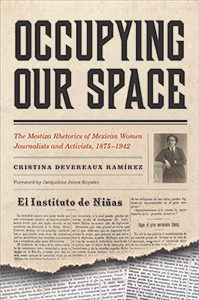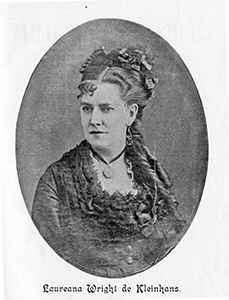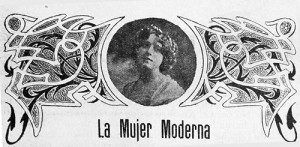Breaking the Silence

Cristina Devereaux Ramírez Photo courtesy UA Press
Cristina Devereaux Ramírez’s Feminist Recovery Project
Cristina Devereaux Ramírez speaks with verve and passion when she talks about the Mexican women journalists she covers in her recently-released UA Press book. Her eyes flash with light and fire. This passion is good, and required. It’s important and time-consuming research that Ramírez is conducting, saving and sharing.
“All of these women were doing something absolutely unheard of at that time (late 19th, early 20th century); for women to write, not just write stories or poetry, but to be writing their opinions and putting them out there!”
She enthusiastically continues: “Women were trying to take back the discursive power, to frame themselves and who they are. Not just at that present moment, but historically as well.”
The book is “Occupying Our Space: The Mestiza Rhetorics of Mexican Women Journalists and Activists, 1875-1942.” Its launch at UA’s Confluencenter for Creative Inquiry Show & Tell event on Wednesday, Sept. 2 will feature Ramírez sharing a multimedia presentation on two of the women in her book and sharing her incredible journey of research.
In “Occupying Our Space,” Ramírez asks the reader to “reconsider the traditional voices, languages, and geographical settings of the rhetorical tradition. It challenges and crosses linguistic, cultural, gendered, and political borders. This book project explores Mexican women’s voices that have been lost, forgotten, or buried in archives and sidestepped for too long in the pages of history.”
While the writing style is rooted in academia – it evolved from Ramírez’s Ph.D. dissertation – it is inspiring in its recovery of Mestiza feminist, rhetorical history centered in the women’s intense struggle to gain full Mexican citizenship rights and make their voices heard. Women were not granted national suffrage in Mexico until 1947; it wasn’t until 1953 that women were given the legal right to run for political office.
 Ramírez provides historical background that allows readers to comprehend the societal context and conditions in which these women were writing. Without it, we’d miss the importance of their work. We would not fully understand how dire the circumstances were for women and indigenous groups and how dangerous it was for them to speak out. Through this background, we can fully appreciate the women’s vanguard role in trying to establish gender and cultural equality in Mexico. Ramírez’s research gives a solid case for including Mestiza voices in the rhetorical canon.
Ramírez provides historical background that allows readers to comprehend the societal context and conditions in which these women were writing. Without it, we’d miss the importance of their work. We would not fully understand how dire the circumstances were for women and indigenous groups and how dangerous it was for them to speak out. Through this background, we can fully appreciate the women’s vanguard role in trying to establish gender and cultural equality in Mexico. Ramírez’s research gives a solid case for including Mestiza voices in the rhetorical canon.
The women Ramírez includes are Laureana Wright de Kleinhaus, Las Mujeres de Zitácuaro, Juana Belén Gutiérrez de Mendoza, and Hermila Galindo. The chapters are comprised of condensed biographical histories and are capped by examples of their writings, presented in the original Spanish with an ensuing English translation.
As Ramírez scribes, “the histories of these women are divergent, yet parallel. They form a pathway in the history of women’s writing from the early discourse of Wright de Kleinhaus in 1887 to that of Las Mujeres de Zitácuaro in 1900. On this trajectory, the writings of Las Mujeres de Zitácuaro served as a bridge to the more radical voices of Gutiérrez de Mendoza and Galindo, who were writing before and during the Mexican Revolution. Persistent and undaunted, each woman claimed the right to a discursive puesto (space/place) in the Mexican public sphere, which had yet to recognize them.”
In order to further situate the Mestiza rhetors in historical and cultural context Ramírez examines Malintzin in chapter one. She was the Nahua “mother at the center of this racial and national identity.” Malintzin was sold into slavery by her mother after her father died; she was subsequently given to the Spaniards by the Yokot’an after Cortes’ troops defeated the Yokot’an in what is now the Mexican state of Tabasco.
Ramírez writes that “for three years (approximately 1519 to 1521), before she took the role of mother of a new Mestizo race, Malintzin stood and spoke at the center of negotiations and conversations between two empires caught in a contact zone.”
“She was a double threat,” Ramírez states with a confident shrug and smile, “because she was the intellectual, linguistic bridge between these empires, between these two men, Moctezuma and Hernán Cortés. They had to go through a woman. How scary and possibly demeaning is that to them? She was called ‘the traitor’ to put her back in her patriarchal place. And so, that’s why I use her as the theoretical base because these women are reclaiming her historical space. Of speaking, and speaking out, in society.”

“Image of Laureana Wright de Kleinhaus as it appeared in the 1910 publication of her book ‘Mujeres Notables Mexicanas’.” Photo caption from “Occupying Our Space,” page 61.
Image courtesy Cristina Devereaux Ramírez
In chapter two, we learn about Laureana Wright de Kleinhaus, a woman of the elite class and a prolific writer in the late 19th century who started the journal Las Hijas [Violetas] del Anáhuac. Also and significantly, Wright de Kleinhaus captured the biographies of over 100 “Mexican women for her book ‘Mujeres Notables Mexicanas’.”
“As an intellectual who read and listened to the history of her homeland,” Ramírez writes, “she recognized that the greatest injustice leveled against indigenous women was their systematic erasure from history.”
“Over 100 years ago, Laureana was doing this history,” Ramírez says with spirited energy. “You can hear the same resonance of what she was saying; feminist historians are saying it now! ‘Where are these histories?’ She was very pioneering at that time. She was a scholar, a historian, a philosopher and a poet. She was amazing. I’m really surprised more people don’t know about Laureana.”
The feminist protests of Las Mujeres de Zitácuaro (MZ) are covered in chapter three where Ramírez writes that the “progressive Presbyterian movement” involved “activists at the forefront of Mexican civic philosophies, which would later be adopted as secular educational values centered on individual, modernist and open public education for men and women.” Further, the MZ’s written protests claimed “their agency as political beings through the nation’s sacred calling for women: motherhood. The women did not eschew their maternal role but, rather, embraced it.”
Chapter four features a riveting overview of Juana Belén Gutiérrez de Mendoza. She “appeared on the Mexican journalistic scene to claim her own rhetorical puesto of protest with her dissident newspaper Vesper: Justicia y Libertad,” writes Ramírez.
“Gutiérrez de Mendoza’s mocking, grassroots, and angry tone soared off the page, affecting and arousing the emotions of those who read her newspaper. Her writings gained such a level of attention that they earned her several incarcerations, forced her into exile in the United States, and prompted the seizure of her printing press several times throughout her life. Her writing also garnered the respect of other revolutionary journalists, activists, and generals throughout Mexico. Her writing career spanned forty-five years (1897-1942) and was punctuated by great social upheavals and movements.”
This woman’s life deserves to be covered by a film or a play, says Ramírez. “She’s the bad ass, she’s the revolutionary. You could absolutely do a film on a woman who was thrown in jail, accused of being a lesbian, went into exile, took on presidents, and was a prolific writer. There’s a story!”

“Masthead of Hermila Galindo’s women’s magazine ‘La Mujer Moderna,’ dedicated to women and women’s issues.” Photo caption from “Occupying Our Space,” page 166. Image courtesy Cristina Devereaux Ramírez
Hermila Galindo, who Ramírez covers in chapter five, is notable for her role in politics as the presidential spokeswoman for Venustiano Carranza between 1914 and 1920. Galindo was afforded the opportunity to bring “the concept of feminism to a much larger audience in Mexico and Latin America.”
“She was given the podium, literally, by Carranza,” Ramírez explains. “He sponsored her, he sponsored La Mujer Moderna, she was able to publish that and he sent her all over Mexico speaking; she went to Cuba. She’s amazing.
“Carranza had Hermila Galindo on his roll, and we see – right after his assassination – (that) she becomes quiet. That’s how it goes in Mexico. If you’re on the side of president that gets assassinated, your gig is up. So she stopped writing, she disappeared.”
Ramírez is intimately knowledgeable about these women; it has been ten years of researching, traveling and writing to get to the publishing of “Occupying Our Space.” This book is a powerful liberation of buried Mestiza feminist, rhetorical history which could have easily been further entombed by the years. Reading these women’s words and chewing on the revolutionary language is extremely satisfying.
If you are riveted by protest voices speaking out for social justice to break the bonds of oppression, this book is for you.
Cristina Devereaux Ramírez celebrates the release of “Occupying Our Space” with a multimedia presentation for the UA’s Confluencenter for Creative Inquiry’s free Show & Tell event on Wednesday, Sept. 2. It happens Downtown at Playground Bar & Lounge, 278 E. Congress St. and starts at 6 p.m. Event details are at Confluencenter.arizona.edu. Information about the book is available at UAPress.arizona.edu. Ramírez’s website is CristinaDRamirez.com.
Category: Books, Community, DOWNTOWN / UNIVERSITY / 4TH AVE




